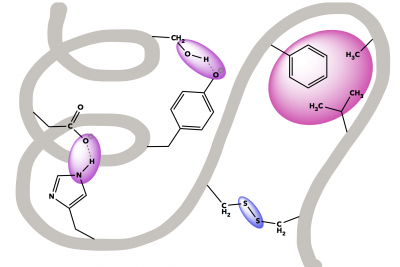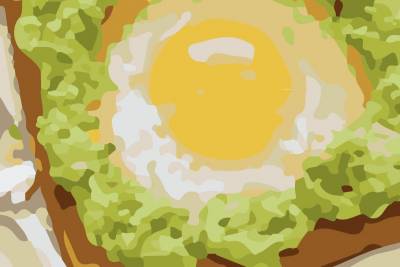Explore How Science is LIT
Try with your students...
Explore How Light Affects Photosynthesis
Materials
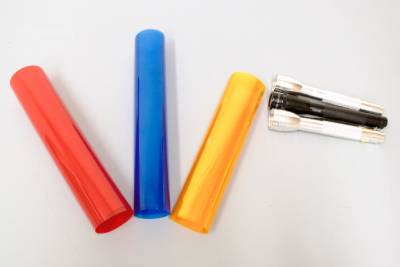
Experimental variables
- Color filter paper
- Table/desk lamp
- Light bulbs (varying intensities and colors)
- Ruler

Laboratory Supplies
- Strainers
- Transfer pipettes
- Water
- Vials with caps
- Freshwater Algae (Scenedesmus, Chlorella, or Chlamydomonas)
- Small beakers or cups
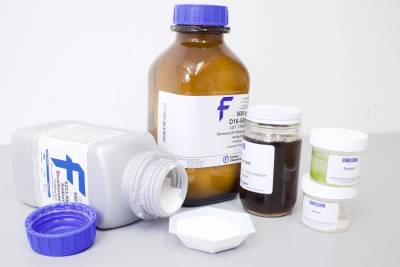
Laboratory Solutions
- 2% Calcium Chloride
- 2% Sodium alginate
- Cresol red/thymol blue pH indicator solution
Protocol
Experimental Bench Set-Up
- ~10 mL of 2% CaCl2 in a cup or beaker
- ~3-5 mL of sodium alginate in cup or beaker
- Strainers
- Transfer pipettes
- Cup with ~10 mL of water
- Empty cup or beaker that holds a minimum of 30 mL
Preparing Algae for Experiment
- Prepare a concentrated suspension of algae. Without centrifuge: leave ~50 mL of algae suspension to settle (preferably overnight), then carefully pour off the supernatant to leave ~3-5 mL of concentrated algae. With centrifuge: Centrifuge ~50 mL of algae suspension at low speed for 10 minutes and then carefully pour off the supernatant, leaving behind ~3-5 mL of concentrated algae.
- In a small beaker, add equal volumes of sodium alginate and then add in the concentrated algae. Gently mix algae and sodium alginate together using a transfer pipette until its evenly distributed.
- Using the transfer pipette, carefully add single drops of the algae/sodium alginate mixture into the CaCl2 to make little “algae balls”
- Once all of the “algae balls” are in the CaCl2 solution, allow them to harden for 5 minutes
- Place the strainer over the empty cup or beaker, and pour over the entire solution of “algae balls” and CaCl2 into the strainer allowing the CaCl2 to pass through, leaving just the algae in the strainer
- Keeping the strainer over the container, pour the water over the “algae balls” to rinse the remain CaCl2
- Transfer your newly made “algae balls” to a new cup or beaker
Setting up Photosynthesis Experiment
- Since this is an inquiry experiment, you can decide to give students a specific experimental variable or have them choose a variable. Some examples of experiments are below
- Distance from light (using ruler) – group can set up vials different distances from one light source
- Different color lights (using color filter paper or different color light bulbs) – group can set up by covering the vials with different colored films and arrange them the same distance away from the light source or set up 1 vial in front of a different colored lamp same distance away.
- With or without light – group places 1 vial in front of an illuminated lamp and another has the vial or lamp covered with black paper the same distance away
- Prior to starting the experiment have students come up with a hypothesis and expected results for their experiments. Be sure to discuss the relationship between pH and photosynthesis progression.
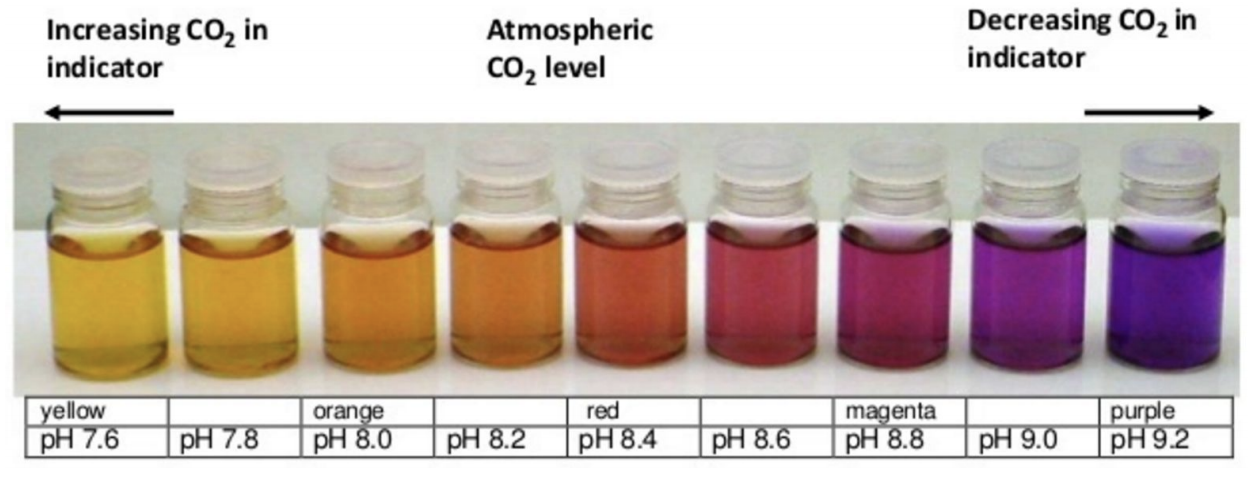
- When starting your experiment, be sure to take note of the time that you placed your vial in front of the light source. Vials should be left for ~1-2 hours.
What would happen if the algae photosynthesizes (increase O2) in a solution that started at pH8.2?
Analyzing photosynthesis results
- After 1-2 hours, return to the experiment. Without disturbing the vials, analyze and take pictures of results. Have students write down the time that their experiment ended.
- Using the color chart above, determine which pH matches your sample the closest.
- Have students determine if they got what they expected and discuss amongst their group members.
Explain how the rate of photosynthesis is affected by their different variables.
The Color of Sunsets
Make some observations
1. What are the different colors in sunlight? How can you break apart sunlight into the different colors?
2. What are the colors you’ve seen in sunsets and sunrises?
3. Looking at the visible spectrum of light, do the colors in sunsets and sunrises have short or long wavelengths?
Since particles in the air scatter smaller wavelengths more, blue scatters more than red or orange, which is why the sky appears blue. If you look close to the horizon, the sky becomes lighter blue or white because the blue light is being entirely scattered away.
In the figure, what time of the day does the light from the sun have to travel through more of the atmosphere to reach our eyes?
At what time will more light scatter?
Which color of light do you think is more transmitted and what color is more scattered at sunsets (at 6 pm in the figure)? What is happening to the blue light?
Based on your observations, propose an experiment
How can you demonstrate for yourself that some sunlight is scattered in the atmosphere?
- Mathematical approach: If all the sunlight directed at the earth makes it to the surface, how would that compare to the light we actually have measured? If we used solar panels to capture that, how much electricity would we generate?
- Experimental approach: Use a light meter or light-sensitive object (e.g. color changing beads, sunlight exposing paper, etc.) to compare the amount of light at different times of the day. Measure over several days to take into account changes in weather, smog, or other factors. Measure over several times in the year to take into account the seasons and earth’s orbit.
- Engineering approach: Build a solar-powered machine, building, etc. Carefully consider where you would put the solar panels to most efficiently collect the light.









